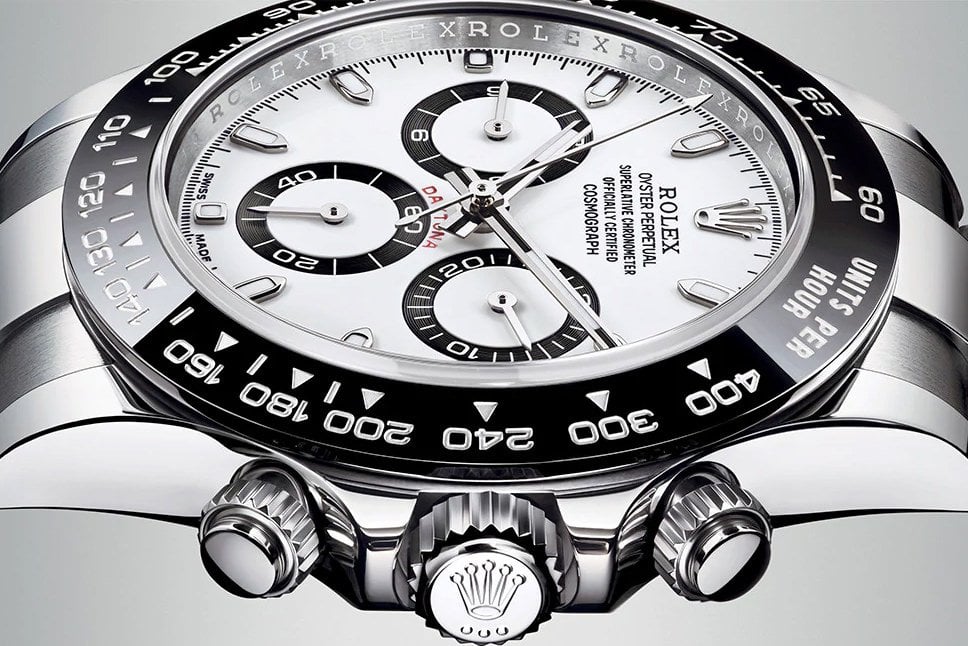The Rolex Cosmograph Daytona is undoubtedly one of the most iconic chronograph watches ever made. Inspired by motorsport and championed by actor and race car driver Paul Newman, the Daytona rightly deserves its revered status as a classic timepiece.
Over half a decade after its launch in 1963, the current Daytona is the result of Rolex’s detailed development process. Each inscription on the dial of a Rolex watch is a guarantee of performance; on this emblematic model, they were added one by one as the watch evolved. Solely “Cosmograph” at the outset, over the years “Oyster”, “Perpetual”, “Cosmograph”, “Daytona” and “Superlative Chronometer Officially Certified” were added, chronicling a legend in watchmaking.

Cosmograph, the Chronograph of the future
In 1963, Rolex launched a new-generation chronograph, the Cosmograph. The name, unique to Rolex, instantly marked it out as a very different new model with a distinctly innovative style. The chronograph counters stood out clearly on the dial due to their strongly contrasting colour: black on a light coloured dial or light coloured on a black dial. The tachymetric scale – a graduation allowing the measurement of average speeds over a given distance using the chronograph seconds hand – was moved from the dial to the circumference of the bezel, opening up and simplifying the dial. Dictated by functional considerations, as is usually the case at Rolex, these features made the chronograph functions far more legible – one of the challenges of the time. They also gave the watch a technical and sporty look making it instantly recognisable. The Cosmograph quickly established its place among the Professional watches, a category created by Rolex in 1953, with models such as the explorer dedicated to explorers and mountaineers, or the Submariner specially designed for deep-sea diving.
Black bezel and screw-down pushers
The Cosmograph evolved in 1965 with the launch of a version that featured screw-down chronograph pushers instead of the pump pushers found on the original model. The screw-down pushers brought the finishing touch to the Oyster concept, and prevented the pushers from being manipulated accidentally. In testimony to its reinforced waterproofness, the name “Oyster” was inscribed on all the dials in addition to “Cosmograph”. Another new feature came in the form of a black Plexiglas insert for the tachymetric bezel. The white graduation increased legibility yet again.


Self-winding movement and Superlative Chronometer
With the arrival of quartz movements in the 1960s–1970s, Rolex nevertheless remained faithful to the mechanical watch and to the Cosmograph Daytona, preparing its future evolution. In 1988, the Daytona became self‑winding. The brand opted for a quality, commercially available chronograph movement, which it then significantly modified to meet its own requirements, replacing more than 50 per cent of the components with parts specifically designed for Rolex Daytona movements.
The resulting new calibre 4030 included, among other features, a Rolex “heart” – an oscillator with a variable inertia balance wheel, Microstella regulating nuts and a hairspring with a Breguet overcoil – as well as a self‑winding module with a Perpetual rotor invented by the brand in 1931. The movement was systematically submitted for official certification to receive the designation of chronometer, attesting to its superior precision. All versions of the new model featured the phrase “Superlative Chronometer Officially Certified” on their dial as well as “Oyster Perpetual Cosmograph Daytona”.
A new Chronograph standard
As a backdrop to the launch of an entirely new interpretation of the Cosmograph Daytona, it is difficult to imagine a more symbolic event than that of entering a new millennium. Introduced by Rolex in the year 2000, this new model – like the first Cosmograph in its time – embodied the chronograph of the future.
This model has a new-generation self-winding chronograph movement – calibre 4130 – specially designed for the Cosmograph Daytona and entirely manufactured in-house. A masterpiece of engineering and micromechanics, replete with innovative and patented technical solutions, this high-performance movement has set a new standard for luxury self-winding chronographs in terms of robustness, reliability, efficiency and precision, as well as for ease of maintenance.


Daytona meets platinum
Fifty years after its creation, the Cosmograph Daytona remains in a class of its own among sport chronographs and continues to evolve. It is the first Oyster model in the Professional range to be offered in platinum, the noblest of precious metals, fitted for the occasion with an ice blue dial, exclusive to Rolex platinum models. It is also equipped with a spectacular monobloc Cerachrom bezel, an exclusive Rolex innovation with exceptional resistance properties and incomparable aesthetics.
New Monobloc Cerachrom Bezel
The new monobloc Cerachrom bezel in high-tech ceramic offers a number of advantages: it is corrosion resistant, virtually scratchproof and the colour is unaffected by UV rays. This extremely durable bezel also offers an exceptionally legible tachymetric scale, thanks to the deposition of a thin layer of platinum in the numerals and graduation via a PVD (Physical Vapour Deposition) process. The monobloc Cerachrom bezel is made in a single piece and holds the crystal firmly in place on the middle case, ensuring waterproofness.


Discover the Cosmograph Daytona collection here. See the watches in person at our London, Liverpool, Altrincham and Manchester showrooms.


Showrooms









